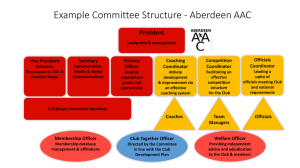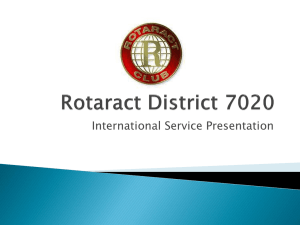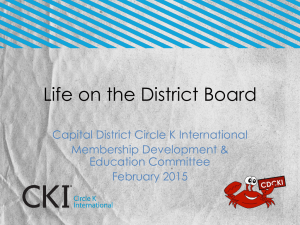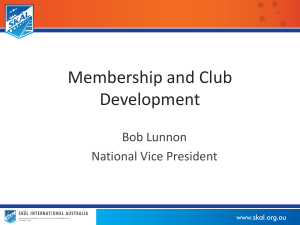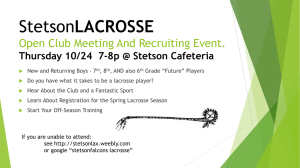13 Impact on Clubs - National Club Association
advertisement
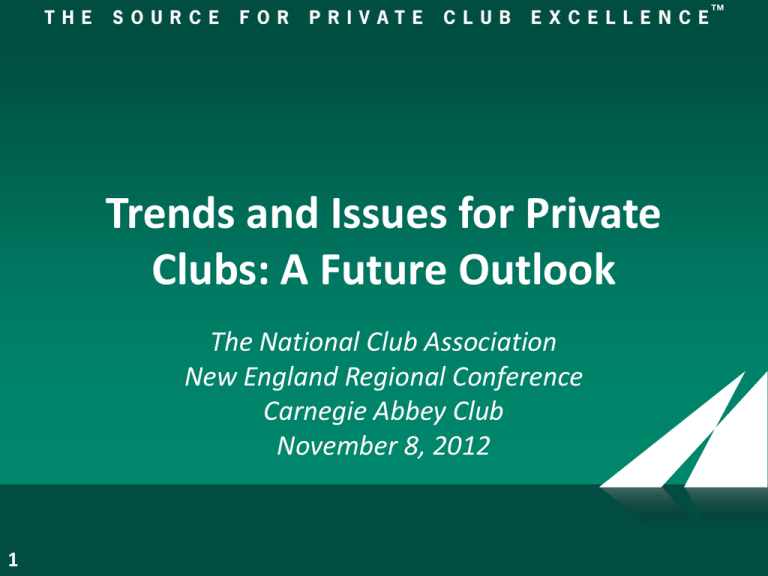
Trends and Issues for Private Clubs: A Future Outlook The National Club Association New England Regional Conference Carnegie Abbey Club November 8, 2012 1 Trends and Issues for Private Clubs: A Future Outlook The National Club Association New Jersey Regional Conference Brooklake Country Club November 12, 2012 2 Forces at Work Challenges for Private Clubs well documented prior to Great Recession. Forces at Work Include: • Older and More Diverse Population • New Household Composition • Decline in Corporate Support for Memberships • Changing Lifestyles • Preference for Casual Dining and Socializing • Increased Competition 3 Sharon Heights Golf & Country Club Menlo Park, California Impact on the Club Industry Total Number of Member-Owned Golf and Country Clubs by Year Down 6% Down 10% 6000 Down ??% 5000 4000 3000 2000 1000 0 1990 4 2000 2010 Est. 2020? 1990 2000 2010 Est. 2020? Population Demographics 5 Demographic Factors Continued “graying” of America • Aging Baby Boomers • Fallow Period Increased diversification. • Growing Hispanic and other ethnic groups Changes in family composition • Evolving definition of family 6 Prime Joining Years: 36 to 45 90 80 70 60 50 Boomers 40 Gen X Gen Y 30 20 10 0 48 to 64 7 32 to 47 17 to 32 Club Responses Bell Curve Membership Plans • Importance of Under 40 Group • Capture Late Bloomers/Downsizers Add Classifications • Time constrained up and comers • Weekday access Redefine age groupings • Conversions to full • Family 8 The Changing Household Fewer than half of households are husbandwife households. One-in-four households living single: • Single women households growing fastest Households increasingly • Postponing or foregoing marriage • Declining birth rates Can clubs capture these segments? 9 Economy 10 Economic Factors Continued Challenges • • • • • The Election Fiscal Cliff Debt and Taxes Healthcare costs Social Security There’s a lot on the plate for a dysfunctional government. 11 The New Economy Women in the workplace: • Two-thirds of women 18 to 34 indicate career success “very important” • Women surpass men in college enrollment and completion New career paths; less stability. 12 Impact on Clubs Companies not supporting membership. Dual income families may have income, but do they have the time to enjoy membership? Biggest factor driving changes in demand and use: how often can we really use the club? Needs: • Appeal to women • Family activities and programs • Child Care 13 Luxury Consumer Expectations Customization: Expect products and services to be specifically tailored to their needs. Distinctiveness: Seek innovators that re-invent the offering and experience. Going Above and Beyond: Want expectations to be exceeded. 14 Evolving Club Business Model Professional managers must drive changes in: • • • • • 15 Governance and Management Membership Development Facility Enhancement Financial Planning Communications Governance & Management 16 It’s All About Leadership Today’s leaders must provide: • • • • • • 17 Creativity and Vision An Understanding of the Environment Sense of Purpose Generate and Maintain a Sense of Trust Catalyst to Achieve Results Challenge Resistance to Change Strategic Management Process 18 Strategic Management Process 19 The CEO Model Former: Triangle management concept of golf, house and course operations reporting to Club President who serves as CEO. Current: Chief Operating Officer model. COO reports to President who reports to Board. Future: General Manager/CEO concept. • Greater managerial strength. • Cleaner operating system. • Greater hedge against micromanagement. 20 The CEO Model Rationale to separate Chair and CEO Roles. • Current model places total authority in unevaluated and largely unaccountable volunteer. CEO concept separates CEO/Chair function. • • • • • 21 Board can clearly negotiate what it wants the CEO to do. Objectively evaluate performance and progress. Greater continuity – no annual CEO. Committees report to CEO. Responsive to the times. Membership Development 22 The First Rule of Marketing You need to have something good to sell. If you want to attract and retain members, provide a membership experience that people want. Some will even want to golf. 23 Membership Pipeline Contacts must become more personal as prospects move through the process. 24 Target Demographic Families Adults ages 35 to 50 Upper income Within 10 miles Sports enthusiasts • Golf, tennis, swimming, fitness • The selective Golfer and/or diner who enjoys a unique experience 25 Distance from Home to Club Over 15 Miles 7% 8-15 Miles 19% 4-7 Miles 30% 26 0-3 Miles 44% Membership Chairman Encourages development of a marketing mindset. Assures Membership Process is understood and user friendly: • Review new member admission process. • Identify potential changes in classifications to promote member growth. • Streamlines procedures regarding number of required forms, posting, etc. • Nomination forms easy to complete and readily available to sponsoring members. • Review eligibility and rules for Sponsors. • Makes certain Membership Committee and Board meet frequently to approve nominations. 27 Get the Right People Involved 80% of new member referrals come from relatively recent joiners – 5 years or less. Ambassador Committee • Conduits to friends/relatives and business and community leaders. • Broad coverage School and church involvement. Occupations (high net worth advisors, real estate brokers, mortgage brokers, professional association leaders, medical and legal professionals, corporate leaders, etc.) 28 Build the Farm Team Lifestyle changes have increased age when membership is feasible/desirable. “40 is the new 30”. • Marriage, birth, home purchases all happen much later than they did 20 years ago. Increase age for full member conversion. Provide very attractive plans and other enticements to get people to join in mid to late 30s. Opportunity to offer lower priced membership while maintaining cost of full membership. 29 Building a Club Membership Unique appeal Engaged membership Sufficient source of prospective new members 30 New Membership Model Facilities Enhancement 31 Facility Management Options Project Planning • Develop a plan for improving a specific area to address depreciation or other inadequacies. Budget Planning • Identify a budget for capital investment and spread it across multiple areas. Master Planning • Develop a comprehensive plan to provide the required/desired amenities to support the club’s mission. 32 Master Planning A master plan is a long term view on facility improvement and development. The highest priority improvements in the master plan are built first as funding allows. Lower priority improvements are completed in future phases. Total plan yields or prevents: • More effective solution. • Continually redoing projects. • A roadmap for the future. 33 34 35 36 37 38 39 Financial Management 40 New Financial Model Align Sources and Uses of Funds. 1) Operating Dues and Fees achieve financial breakeven. 2) Use Capital Dues (based on accurate reserve model) to fund ongoing maintenance and repairs to existing facilities. 3) Use debt repaid from initiation fees to fund major capital projects. 41 Financial Opportunities Ensure club is operating efficiently and effectively. Update capital reserve study. Develop financial model: • Annual cap ex funded by members and other sources of income. • Determine capital requirements and operational impact of capital improvement proposals. Periodically distribute financial information to members on the results of operations and the capital financing program. 42 Communications 43 Communications Central element in strategy: • Builds Awareness. • Motivates Members. • Broadcasts Image to Outside World. 44 Personalized Communications Intense demand for personalized communications. Generic communications off-putting. Social media creating desire to be in the know on everything. Evolving technology and member preferences complicate communications challenge. 45 The Private Club Advantage Leverage unique relationship. Personalized newsletter. Two-way dialogue. Help members understand activities and strategy. 46 Summing Up 47 Is This the Death of the Private Club? No…they just need to evolve. • People still highly value associational benefits of membership, as long as it fits their lifestyle. • Clubs are social institutions that must respond to the changing world around them. • There is a difference between respect for traditions and being tradition-bound. • You can improve the success of your “golf club” by making it a better all-around club. 48 Where Are We Headed? Cyclical and secular trends continue to forecast flat to declining golf play. In order for clubs to succeed in the decade ahead, they must: • Know their members. • Know their marketplace. • Operate with a strong sense of mission and purpose. 49 Thank You for Listening. Questions? 50 Baltusrol Golf Club Springfield, NJ
